What the Switch SFP Port Is and How It Enables Network Expansion and Flexibility
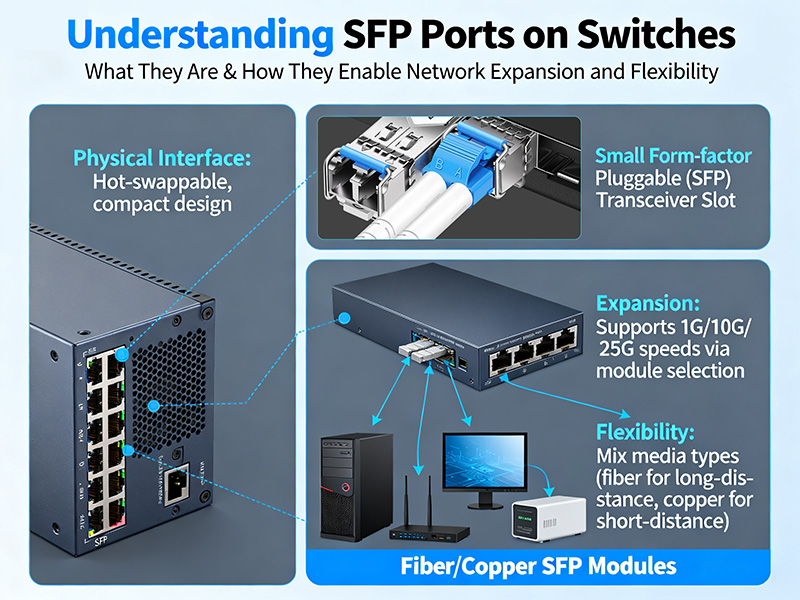
Switch SFP ports may feel like a technical enigma, but they are valuable assets when creating flexible and scalable networks. SFP ports provide support for connection types and speeds that are great opportunities for network designers and administrators who are aiming to support performance and flexibility in their networks. Understanding the basic elements of switch SFP ports creates a much clearer conception of how networks can grow and adjust without the cost of complete rewrites of the infrastructure. By knowing the main types of SFP ports, you can mitigate vague and speculative decisions, providing assistance with selecting modules and configurations for your specific needs. This post opens the door to practical applications, turning these small modular slots into enablers for your network. Through explanations, real-life examples, and comparative data, this post will show the breadth of switch SFP ports you can take from elementary knowledge to advanced applications for the agility of your network.
Grasping the SFP (Small Form-factor Pluggable) port
Grasping the SFP (Small Form-factor Pluggable) port redistributes the concept of modularity. An SFP port is a flexible slot that accepts transceiver modules, which you swap out for connecting network devices. You can connect media via fiber optic or copper cables—SFP ports provide you with options to adapt to varying network demands. SFP ports’ flexible media connections are in contrast to fixed connectors such as RJ45 Ethernet ports, which primarily rely on copper cables with defined speeds and cable requirements. RJ45 ports offer heavy-duty connections and compatibility, but they rarely (if ever) offer flexibility in modularity at the degree that SFP slots offer, which can support varied speeds of connection and transmit modulated media by swapping modules.
SFP slots physically look like a small open bay on the face or front panel of a switch or router. The modules inserted into the bays or slots determine the type of physical connection, for example, multimode fiber, single-mode fiber, or copper connections. This modular design means that you now have a platform that can respond to changing network demands without replacing hardware. The switch SFP port capability extends beyond basic connectivity since they also support rapid scalability and ease of upgrades. For many SFP ports, they also support hot swapping, which means you can swap out the module without powering down the device, thus limiting downtime and service disruption. The switch SFP port, through versatility, meets the need for scalability, flexibility, and performance goals in complicated networking environments.
What is a Switch SFP Port and Why Is It Essential for Modern Networks?
A Switch SFP Port means Small Form-factor Pluggable port, which is a small modular port that accepts different transceiver modules. Essentially, an SFP port is a flexible port that can accept different fiber or copper cabling for network devices depending on the need. An SFP port is different from an Ethernet port that is fixed and thus pre-defined because the SFP port is empty until a module is placed into it and defines its function according to the needs of the network protocol. An SFP slot has the appearance of a small cage mounted on a switch or router. The modular nature of the SFP port provides a clean, standardized method of insertion and replacement.
 This means device power does not need to be turned off to remove or install modules. This is much different from RJ45 Ethernet ports that are fixed connectors using copper cables, designed for one standard type of connection and speed. While RJ45 ports create a solid connection and are flexible in use for multiple Ethernet applications, the flexibility to accept cargo or cable does not mean the same as SFP ports being able to accept different, if not multiple, media types and transmission rates from the same interface just by removing and replacing a specific module. The function of the switch SFP port is much more than mere connectivity.
This means device power does not need to be turned off to remove or install modules. This is much different from RJ45 Ethernet ports that are fixed connectors using copper cables, designed for one standard type of connection and speed. While RJ45 ports create a solid connection and are flexible in use for multiple Ethernet applications, the flexibility to accept cargo or cable does not mean the same as SFP ports being able to accept different, if not multiple, media types and transmission rates from the same interface just by removing and replacing a specific module. The function of the switch SFP port is much more than mere connectivity.
The modular design allows for easy upgrades and mixed media connections (e.g., fiber optics, copper) to keep up with changing infrastructure needs. Additional flexibility is added due to the convenience of hot-swapping, allowing network administrators to change or upgrade SFP modules without interrupting network operation. This means less downtime and easier maintenance.
SFP ports also allow for scalable solutions by supporting wired modules that can support varieties of speeds and transmission distances. This removes the need to undertake replacing entire network devices anytime a change in requirements arises. Simply swapping a single module creates opportunities for network expansion without changing much investment. In a nutshell, the SFP port slot functions as a “universal socket,” accommodating different speeds and cables as opposed to RJ45 ports, which are locked into one configuration. With increased flexibility of the socketing options to easily conduct frog jumps within evolving infrastructure integrations as new devices are planned as upgrades, is a big reason why the switch SFP port continues its central role within agile networks.
How Do Different Types of SFP Ports Impact Network Performance?
There are several types of switch SFP ports that impact network performance in different ways. The first notable difference is between SFP and SFP+ ports. Generally, SFP ports are rated for speeds up to 1 Gbps.
SFP+ ports, however, double that potential to 10 Gbps for those networks that need the added bandwidth. SFP+ ports are even backwards compatible with SFP. This means that network upgrades could be just as simple as swapping out one SFP for another SFP+ port, without replacing entire network setups. Combo ports are also interesting in that they combine an SFP port with an RJ45 port.
Combo ports allow network managers to choose between the connection types in the same physical port. They have made it easy for networks to switch from fiber to copper interfaces, providing high-level flexibility without having to purchase an additional interface. When using a combo port, however, only one of the ports is active at any one time because they share bandwidth.
When planning out network infrastructure like this, it’s important to be aware of these limitations, especially when planning a network with high traffic where full throughput would be required. Industrial-grade SFP ports are designed for harsher conditions, including extreme temperature ranges, vibrations, and electromagnetic interference. While they have similar form factors, industrial-grade SFP ports have rugged casings and long-lasting durability, both of which make them perfect for outdoor or factory-based networks. Industrial-grade SFP ports help ensure that uptime and connectivity are reliable and stable for network-critical applications, where there is no option for loss of connection.
Thus, the importance of choosing SFP or SFP+, a combo or standard port, or an SFP port in an industrial-grade environment is extremely significant. By understanding these distinctions in SFP and SFP+ speeds, combo ports’ shared bandwidth nature, and the environmental stability and strength of the SFP port types when comparing an industrial switch to a standard switch, network architects can begin deciding on infrastructure that will be performance-compliant for their clients. Ultimately, the knowledge around these port types will once again lead to recommending infrastructure that aligns to the operational needs of the user when it comes to network scalability.
| Port Type | Max Speed | Key Feature | Typical Use Case |
| SFP Port | 1 Gbps | Flexible modular slot | General LAN and fiber links |
| SFP+ Port | Up to 10 Gbps | Backward compatible with SFP | High-speed data centers |
| Combo Port | 1 Gbps (shared) | SFP + RJ45 in one physical slot | Mixed environments with varying needs |
| Industrial SFP Port | Varies | Ruggedized for harsh conditions | Outdoor, factory, or transport networks |
By knowing the differences between the types of ports, you will help prevent misconfigurations and promote flexibility and effectiveness for networks to meet operational requirements.
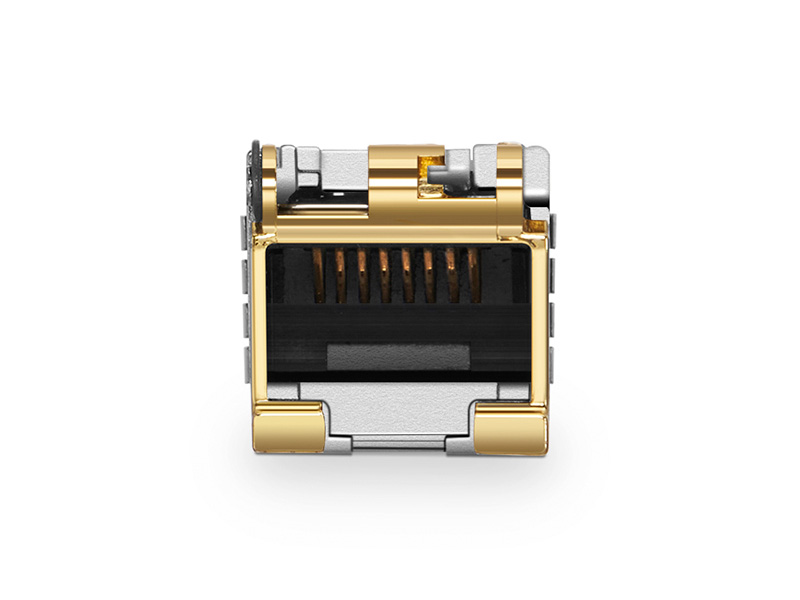
RJ45 ports
How to Choose the Correct SFP Module for Your Switch: A Practical Framework
Selecting the appropriate SFP module is essential for maximizing reliability and efficiency in your network. Start by assessing critical elements such as speed and distance of transmission. SFP modules come in a variety of data rates, from 1 Gbps to 10 Gbps and beyond. Transmitting data over longer distances usually involves fiber-optic SFPs, while shorter distances typically rely on copper modules. Assessing the fiber type is important too, because single-mode fiber offers the best outcomes for long-distance links carrying signals for kilometers with little signal degradation. Meanwhile, multimode fiber usually works best for short distances within a building or campus. Choosing the right type of fiber will directly affect the quality of the signal and the reach of the network. Copper SFP modules are an affordable option for short-range connections, offering easier installation and compatibility with existing Ethernet connections.
But while fiber SFP modules are more expensive, they deliver better speed, interference resistance, and scalability over long distance than copper modules. Determining how to balance the advantages and disadvantages of each type based on your network topology is ideal for deployment. Compatibility continues to be a critical consideration. When possible, the best practice for SFP module compatibility with a switch is to use certified modules recommended by your switch manufacturer. Using a certified module should decrease connectivity errors such as link down or passive optical LAN (PON) connections and result in better overall performance.
Some non-manufacturer certified modules may work on a switch initially, but they commonly degrade over time or may even void the warranty status of your device.
| Key Criteria | Consideration |
| Speed | Match module to required data rate |
| Transmission Distance | Use fiber or copper based on range needs |
| Fiber Type | Single-mode for long, multimode for short links |
| Compatibility | Prefer certified modules for seamless integration |
The use of this framework to select SFP modules diminishes trial-and-error and maximizes the useful life of your network. Selecting the appropriate SFP module facilitates less disruptive expansion, uninterrupted performance, and meets your specific needs.
How Can Switch SFP Ports Be Used to Expand Network Reach and Capacity?
The role of switch SFP ports is critical to extending the reach and capabilities of the network. SFP ports provide versatility and connect beyond standard copper links, which gives networks greater ability for expansion by adding connection ports. One implementation of this is uplink aggregation. Dedicated SFP ports on switches can be combined to either provide more bandwidth between switches or network segments.
A switch’s uplink SFP ports, then, strengthen the network’s backbone with applied bandwidth from multiple SFP ports, while also providing redundancy to the backbone connection. In traditional data center networking, SFP ports facilitate the implementation of fiber module SFP ports connected to critical services such as databases, servers, and storage units that span long distances without latency when working with end-user data. Additionally, SFP ports provide a modular architecture that allows network engineers to grow by adding links appropriately, thus advancing high-speed links within the parameters of scope.
While campus networks are almost exclusively built using SFP ports, they are the primary method by which buildings are interconnected over any distance using fiber optics to extend reach while not losing connectivity.
Future-proofing the network entails the selection of an SFP module that aligns with both the current parameters and the parameters of growth in the future. By selecting fibers that have appropriate length specifications and ports that support higher-level speeds, upgrades will require only the addition of a new cable or module. Finally, as generally discussed, integrating switches with multiple SFP slots can enhance the infrastructure of networking while providing proper conditions for swap-out compatibility of network infrastructure.
| Use Case | Benefit |
| Uplink Aggregation | Increased bandwidth and redundancy |
| Data Center Links | Low-latency, high-speed scalable design |
| Campus Networking | Extended reach across buildings |
Understanding the above application also contributes to the design of flexible and resilient networks. SFP ports on switches can be employed strategically to build out capacity or extend connectivity in varied environments while also extending the life of the switches.
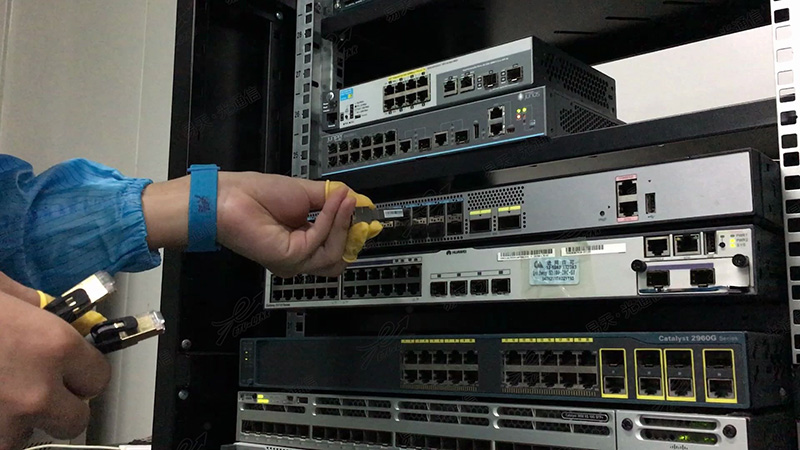
RJ45 ports application
How to Troubleshoot Common Issues and Maintain Switch SFP Ports Effectively?
Obstacles to troubleshooting switch SFP ports usually begin with diagnosing common issues like a module not being recognized or a link being sporadic. The first step to finding a resolution to the issue is to confirm that the module is placed securely in the SFP slot, as loose modules are usually the cause of faults. The second step to troubleshooting is to confirm the switch and the module firmware are compatible, since most of the time, firmware mismatch issues arise from not being on the same or newer channel of firmware. Another innovative approach that greatly simplifies SFP port fault testing and SFP port health is Digital Diagnostic Monitoring (DDM).
Digital Diagnostic Monitoring allows for new insights into networking passive optical modules, enabling the engine of the network to generate feedback on key health metrics including temperature, voltage, and optical power. In doing so, network administrators can gain actionable data on potential operational risks, where further investigation on module performance can be readily diagnosed before degradation of the passive optical system takes place. Generally speaking, operating SFPs according to manufacturer instructions and routinely maintaining the SFP can lengthen the service life of SFP ports as well as modules. Routine cleaning of optical connectors, or using proper cleaning tools, can alleviate signal loss caused by particulate build-up. In addition to cleaning optical connectors, it is best to minimize how often the SFP or entire system is plugged and unplugged from electrical service unless under necessary circumstances, to maintain mechanical integrity over time.
| Troubleshooting Step | Purpose |
| Verify module seating | Ensures solid electrical and optical connection |
| Confirm firmware match | Prevents recognition and compatibility issues |
| Use DDM monitoring | Monitors health and prevents unexpected failure |
| Clean optical connectors | Maintains signal quality |
By adopting these basic practices, you create a proactive way of maintaining configuration and management of the switch SFP ports. Effective troubleshooting, paired with routine and predictable maintenance, provides for good connectivity and maximizes network hardware lifetime.
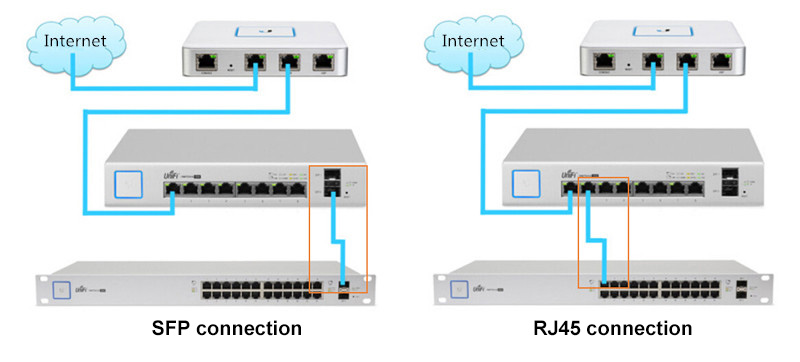
What Can We Learn from a Real-World Network Transformation Using SFP Ports?
An enterprise lowering its bandwidth requirements in their network performed a major network upgrade related to the implementation of SFP ports. Replacing fixed RJ45 connections to the network switches with SFP slotted ports and fiber or copper module adapters based on the types of links needed with that port type allowed for a more flexible and easier implementation as the network demands increased. The most prominent benefits were that organizations experienced an increased data throughput of 40% along with a decrease in connection latency across their most critical connections. Flexibility was enhanced because network administrators could hot-swap a module without taking down those connections.
That significantly helped when they needed to take things offline to upgrade configurations to the backbones or repair critical connections to maintain consistent improvement statistics. However, the critical lesson highlighted in the case study was that while implementing these upgrade strategies and enhancements was beneficial, organizations must adhere to certified or explicitly compatible SFP modules rather than mixing with third-party SFP-like module connections or hybrid SFP connections. This lesson was better learned in cases where they tried mixing installed module configurations with non-explicitly recommended, third-party installed module configurations. In some of those cases, they would either not work correctly or would lead to problems.
| Outcomes | Details |
| Performance | 40% increase in throughput, lower latency |
| Flexibility | Hot-swappable modules reduce downtime |
| Lessons Learned | Use certified modules to avoid faults |
This real-world network upgrade demonstrates how smartly taking advantage of the switch SFP ports can improve speed and flexibility, and highlights an important lesson about SFP module selection and future maintenance.
How to Choose the Best SFP Module for Your Budget: Comparative Analysis
Choosing a suitable SFP module involves finding the right balance between performance, cost, and applicability. Entry-level modules provide basic 1 Gbps speeds at a small price with reasonable performance for small offices or easy links. Mid-level modules reach speeds of 10 Gbps, frequently with the ability to reach longer distances on fiber, suitable for networks with predictable growth and increasing bandwidth needs.
Advanced modules push communication technologies to new limits with low latency and advanced speed. However, the price for these modules can be significant and best suited for data center or mission-critical environments.
An objective price-performance evaluation can guide a network operator in matching SFP selection against a network operating goal. For example, the expense of a 10 Gbps fiber module will be worth the investment if the module allows for fewer future upgrades for anticipated growth and potentially saves more (the costs incurred through future upgrades or expenditures). In the example of lower-cost copper modules, the scenario may be profitable but dedicated to a very short band of distances where price takes precedence.
| Module Tier | Speed | Price Range | Ideal Use Case |
| Entry-level | 1 Gbps | Low | Small offices, simple links |
| Mid-range | Up to 10 Gbps | Moderate | Growing networks |
| High-end | 10+ Gbps | High | Data centers, critical apps |
Popular modules such as certified branded SFPs deliver the best compromise between safety and price. Open-market alternatives can look tantalizingly cheap, but they may jeopardize compatibility or shorten the lifespan of the units, which can jeopardize the stability of the network. In the end, the best SFP modules are the ones that meet specific needs while not exceeding the budget and providing the promise of reliable, lower-cost, high-quality expanded networks. This comparison provides informed purchasing options, ultimately leading to the most optimized network capability and budget expenditures.
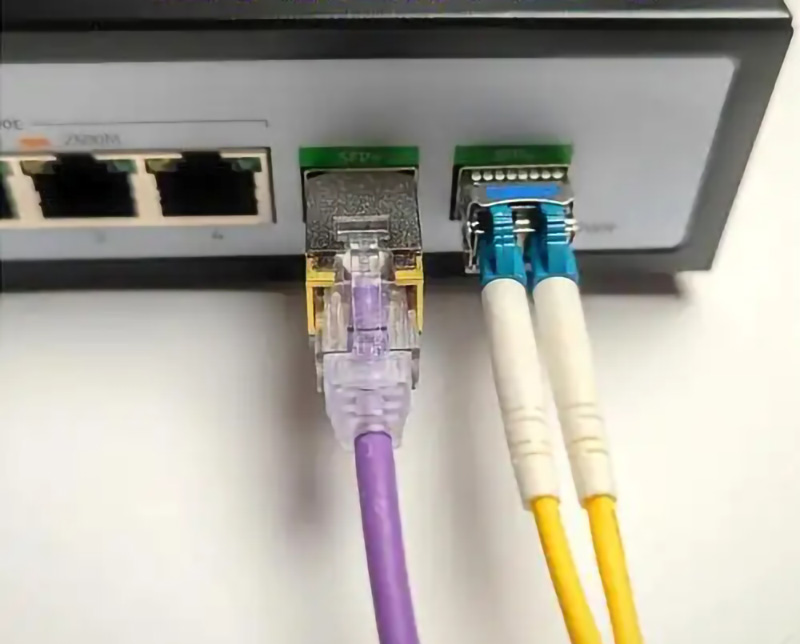
What Does the Future Hold for SFP Ports: Emerging Trends and Standards?
The pace at which SFP ports are developing is speeding up. The deployment of new technologies such as the SFP28, which supports a data rate of up to 25 Gbps, is accelerating network rates beyond traditional limits.
This shift in technology means the ability to make faster and denser connections, which are vital in data centers or high-performance computing environments. Being aware of and following SFP evolution can help assure your networks remain scalable and handle ever-increasing traffic demands without the expense of slogging through all of the high-performance system upgrades. It’s often the case with newer SFP modules that there is improved power efficiency and lower latency characteristics that deliver performance enhancements to the entire system. There are new and emerging industry standards focused on achieving faster speeds, greater interoperability, and diagnostic capabilities. These trends also affect new switch designs that incorporate a more modular port design with future-ready ports while enhancing bandwidth requirements and backward compatibility.
| Trend | Impact |
| SFP28 | Faster data rates, denser connections |
| Industry Standards | Improved interoperability, diagnostics |
| Future Network Trends | Scalable, efficient, backward-compatible |
Thinking through these things today will also help build resilient networks that meet future needs.
Conclusion
The switch’s SFP port is a foundation of scalable, flexible network design. The SFP’s modular design allows for different media types and speeds while allowing networks to grow with minimal hardware changes.
This makes expansion more straightforward and continues to deliver consistent levels of performance. Understanding how to choose, use, and maintain SFP modules will improve network performance and longevity.
Making the right choice can dramatically reduce downtime and compatibility issues, and routine maintenance can extend the life of the hardware. Grasping these essential concepts will allow network designers and administrators to create networks that can adapt to the future. Using the switch SFP port will ultimately help create optimized use of connectivity to meet changing demand.
